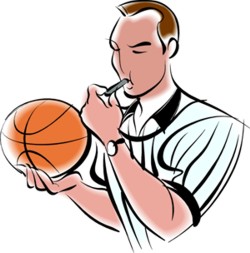Current Rules Basketball? If you’re a beginner or just need a revision on the rules, here’s the place…
The current rules of basketball have steadily evolved and vary greatly from basketball rules when the game was first invented. For example, such common place rules like the three-point line, shot clock, and 3 seconds in the key were not enforced until the past few decades.
In fact, basketball first started out as a game where certain players had to remain stationary the entire game and passing was only allowed. It was not uncommon to witness an early basketball score of 2-1.
Basketball slowly evolved into an offensive explosion, where NBA scores ranged in the mid-100’s and players like Wilt Chamberlain could dominate because there was no 3 seconds in the key.
Today the game is more defensive orientated on all levels, although the three point shot has allowed scoring to remain high.

Current Rules of Basketball
The most important aspect of basketball is dribbling. It’s important to master dribbling because so much of the game revolves around it. As you already know, you cannot advance the ball with your own two feet without dribbling.
“Traveling” is basketball’s most basic rule. It follows a pretty simple formula. If you take a step you need to dribble the ball. Anytime you walk without dribbling the ball, you travel. A travel results in a turnover, awarding possession of the ball to the other team. A player also cannot dribble the ball, pick the ball up, and dribble again. The infraction is known as a “double dribble.”
3 Seconds in the Key: An offensive player cannot stand inside the paint or key for more than 3 seconds at any given time. Originally this rule was not enforced, allowing extremely tall players to just stand under the hoop and receive passes for easy buckets. 3 Seconds in the Key is a defensive rule that gives smaller team’s a shot of winning.
Over the Back: Rebounding is critical in the game of basketball. In order to rebound well, team’s must “box out.” Box out entitles the rebounder keeping the opponent on his or her back side while he or she pushes the opponent away from the hoop with the back. Over the back fouls are often called because the opponent boxed out well.
Why? If you are being boxed out and prevented from going forward with your lower body, the natural reaction is to reach over the back with your upper body and arms. You cannot reach over an opponent’s back to get a rebound. The rule was instated to prevent taller players from merely grabbing the ball over shorter opponents.
Shot Clock: High school and pick-up games do not utilize a shot clock, but college and professional leagues do. A shot clock is a predetermined amount of time the offensive has to shoot the ball before they are called for a shot clock violation. The ball must hit the rim to reset the shot clock.
Every time the possession of the ball changes, the shot clock resets. Shot clocks are enforced to prevent offenses from holding onto and delaying the game especially when they have the lead late.
Three Point Shot: The three point basket surprisingly was only invented a few decades ago, but because the shot is so popular now-of-days, people often misconstrue it as being a original rule of basketball. Current rules of basketball awards an offensive player three, instead of two points – when both his and her feet are behind the three point line.
The distance away from the hoop of the three point line varies depending on the level of competition. Some old-school players and fans feel the three point line has ruined the integrity and basic fundamentals of the game.
Return from Current Rules Basketball to Rules of Basketball
Return from Current Rules Basketball to Best Basketball Tips
